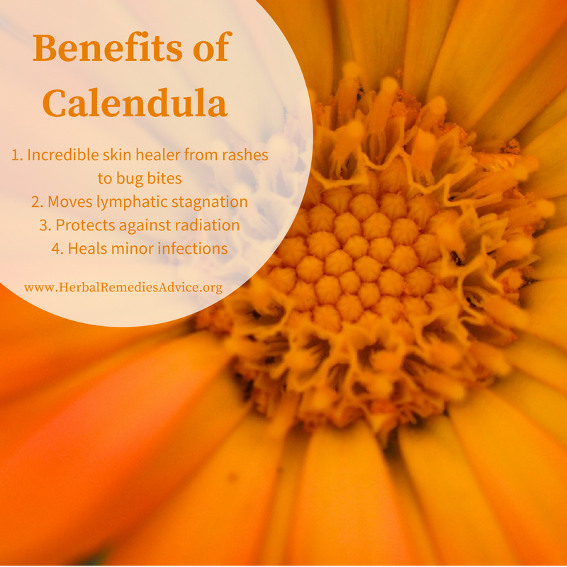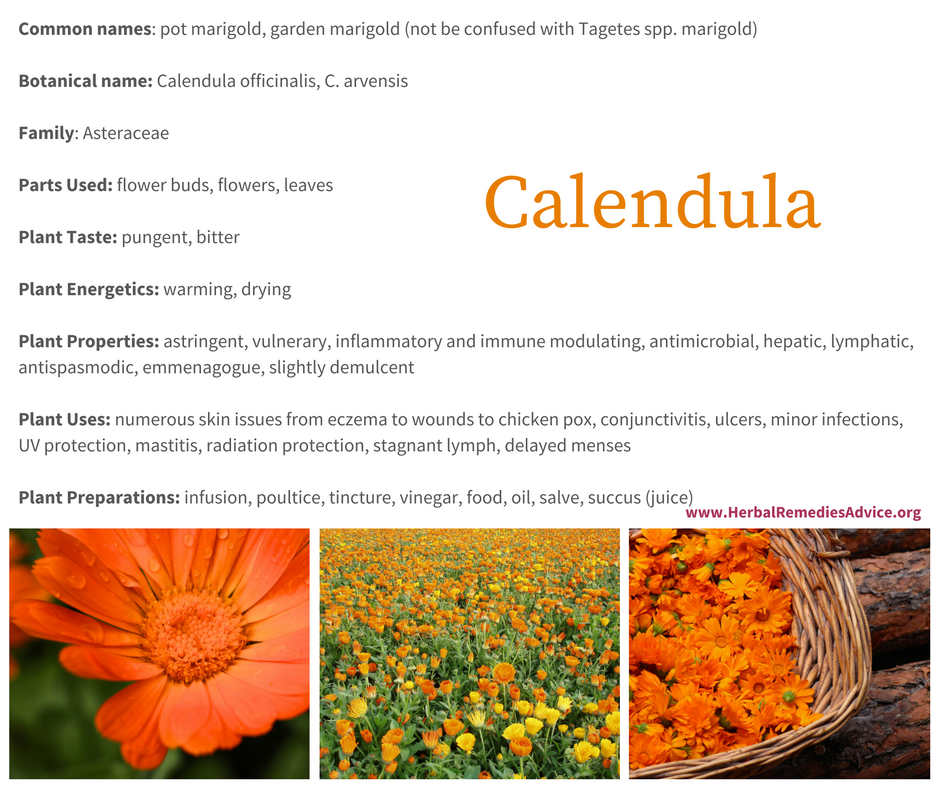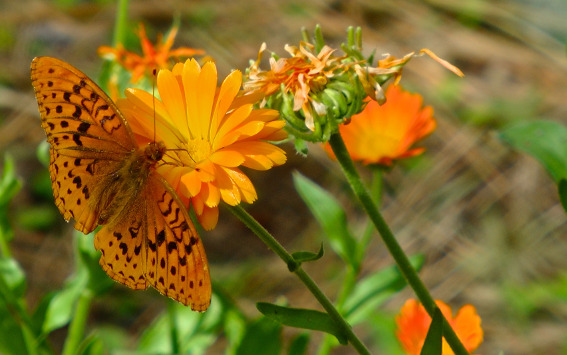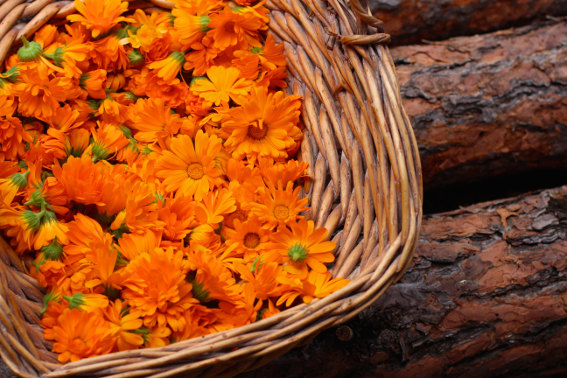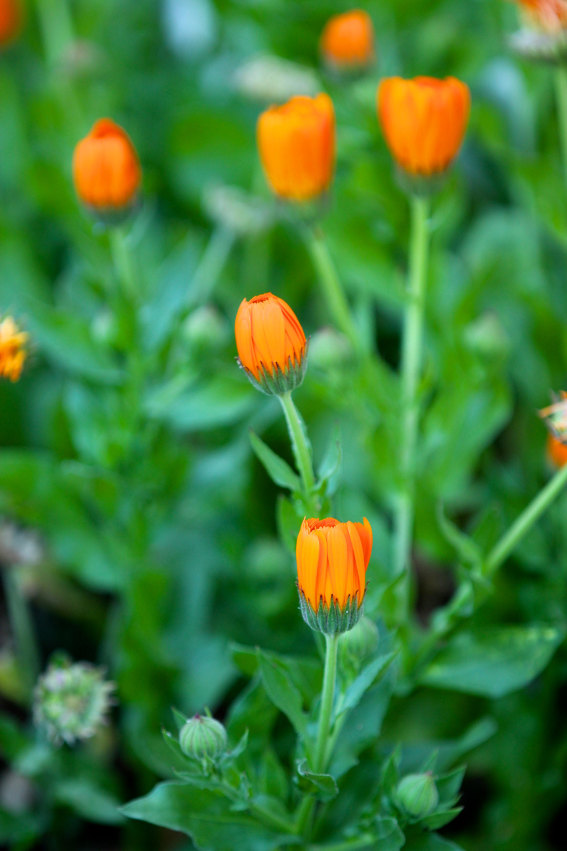Get weekly tips, recipes, and my Herbal Jumpstart e-course! Sign up for free today.

Calendula Benefits
Share this! |
|
If you were to walk away knowing only one thing about calendula benefits, it would be that there are countless gifts from calendula flowers for the skin! Calendula heals wounds, relieves inflammation, increases beneficial immune responses, is mildly antimicrobial, and even protects the skin from radiation damage. In this video I am going to share in-depth information about calendula and show you how to make calendula oil.
-- TIMESTAMPS --
- 00:00 - Introduction to calendula (Calendula officinalis)
- 02:33 - Calendula for the skin and mucous membranes
- 02:54 - Calendula for itches, rashes and scratches
- 03:49 - Calendula for bug bites
- 04:03 - Calendula for skin health
- 05:25 - Calendula for skin burns and preventing scars
- 06:18 - Calendula for varicose veins
- 06:41 - Calendula for ulcers, digestive wounds, and leaky gut
- 08:39 - Calendula for dandruff
- 08:58 - Calendula for postpartum care
- 09:39 - Why is calendula so beneficial for the skin?
- 10:47 - Calendula for liver support
- 11:21 - Calendula’s diaphoretic action
- 11:36 - Calendula for cancer and stagnant lymph
- 12:40 - Calendula’s antimicrobial action
- 13:17 - Calendula as food
- 13:49 - How to grow and identify calendula
- 15:13 - Working with calendula
- 15:43 - Calendula harvesting tips
- 17:14 - Calendula preparation tips
- 18:53 - Special considerations for working with calendula
- 19:12 - Calendula infused oil
- 20:33 - How to make strong calendula oil
- 22:54 - Calendula fun fact
Download Your Free Ebook!
There is an art to making powerful herbal infused oils! There’s so many variations between dried herbs vs. fresh herbs and even which oil to use.
Herbal infused oils are one of the many herbal preparations that we teach in our herbal medicine course, Rooted Medicine Circle.
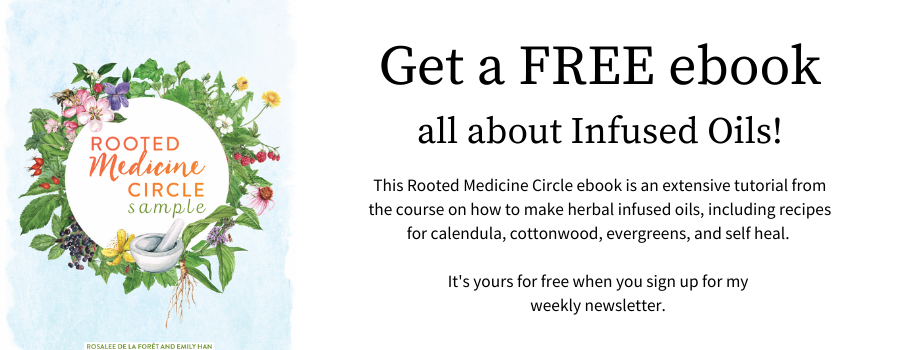
Transcript of the Calendula Benefits Video
Calendula is a common garden flower in the Aster family that now grows in temperate climates all over the world. It generously blooms in bright orange and yellow blossoms throughout the summer and often reseeds itself, returning again every year. Besides offering beauty wherever it grows, calendula benefits have been used for thousands of years for myriad medicinal applications.
Calendula Benefits for the Skin and Mucous Membranes
If you were to walk away knowing only one thing about Calendula’s many herbal uses, it would be that it is a premier herb for the skin and mucus membranes. It heals wounds, relieves inflammation, increases beneficial immune responses, is mildly antimicrobial, and even protects the skin from radiation damage.
When applied to a wound it is seldom that any suppuration follows, the wound healing by replacement or first intention. It has been tested by several practitioners, and by one, is used after every surgical operation with the happiest effect. You need not fear to use it in wounds, and I would not be without it for a hundred times its cost. - King’s American Dispensatory
Here’s a look at the many ways we can employ this brilliantly blooming plant for the skin.
Calendula Benefits for Itches, Ratches, and Scraches
Think of calendula as an all-purpose plant for any manner of skin problems. Do you have itchy dry skin? Use some calendula cream or body butter. Have a mysterious rash? While figuring out the root cause of the rash, reach for calendula to soothe the discomfort.
For minor scratches or wounds, try a calendula salve or poultice. It promotes wound healing by stimulating proliferation and migration of fibroblasts.1 It is also mildly antimicrobial, helping to prevent infection.2
Calendula is one of my favorite herbs for dealing with diaper rash. I recommend it as a salve or cream and it can be used as a preventive as well. When tested on the bottoms of 33 children under the age of 3, calendula was found to be both safe and effective for diaper dermatitis.3
Calendula Benefits for Bug Bites
Calendula can soothe many bug bites, including the bites of mosquitos and the stings of bees. Herbalist and aromatherapist Jade Schutes even uses it for those super-itchy chigger bites.
Calendula Benefits for Skin Health
Herbalists have long used calendula for skin health, including it in luscious creams or even herbal steams. Science has further validated this use by showing that calendula improves elasticity and skin hydration.4 I recommend frequently using calendula creams on your skin to keep it healthy, soft, and pliable.
Calendula can also be used to promote skin health after the skin has been damaged.
Calendula can protect skin after it has been exposed to the side effects of radiation therapy. One study showed that calendula worked better than the regularly prescribed pharmaceutical. In the study, 254 patients were given either trolamine (TEA) or calendula cream to apply after receiving radiation treatments. The researchers found that “The occurrence of acute dermatitis of grade 2 or higher was significantly lower (41% v 63%; P<0.001) with the use of calendula than with trolamine. Moreover, patients receiving calendula had less frequent interruption of radiotherapy and significantly reduced radiation-induced pain.”5
Calendula Benefits for Skin Burns
Calendula creams, oils, and body butters can be used to soothe the skin after a sunburn. It helps to relieve inflammation and pain while promoting new tissue growth.
In addition to supporting skin that has been burnt by the sun or radiation, calendula also helps to heal tissues that have been burned by fire or by heat in the kitchen. Fresh poultices and hydrosol washes are two of my favorite ways to use calendula for this purpose.
It is especially applicable to severe burns, to promote healing and to prevent the formation of a contracting scar. - Finley Ellingwood
Calendula Benefits for the Prevention of Scars
Calendula can be used to decrease scar tissue, whether it is from wounds or from surgical scars. I like to apply it regularly as an infused oil combined with St. John’s Wort oil and rose hip seed oil.
Calendula Benefits for Varicose Veins
Calendula can be used both externally and internally to support blood vessel health and decrease varicosities, including hemorrhoids and varicose veins. I like to recommend it internally combined in a tincture or tea with yarrow and horse chestnut when using it for this purpose.
Calendula Benefits for Ulcers and Wounds
As a vulnerary, Calendula promotes the healing of wounds, even serious ones. In one study, patients with venous leg ulcers were divided into two groups. One group was treated with a calendula ointment twice daily for three weeks. The other group of people was treated with saline solution dressings. After three weeks, those being treated with the calendula ointment had a statistically significant acceleration of wound healing over those being treated with saline solution.6
Calendula’s wound healing, antimicrobial, and inflammatory modulating effects will also work well for internal ulcers. It works best as a long infused tea for these gastrointestinal “wounds.”
Calendula Benefits for Chicken Pox
I first learned from Lesley Tierra that calendula tincture can be applied to chicken pox sores to decrease the pain and itching. I’ve since seen it work wonders in this application!
Calendula Benefits for Dandruff
Regular applications of a calendula ointment can help to decrease dandruff. This may be due to its antimicrobial effects (dandruff can be caused by fungus) or to its vulnerary and inflammatory modulating effects.
Calendula Benefits for Postpartum Care
Calendula is one of my favorite herbs for mothers in postpartum care. The flowers can be made into a strong tea for a sitz bath to heal the perineum (I often combine this with plantain and Uva-Ursi). The fresh flower poultice or salve can be used on tender nipples. I’ve seen the tincture applied topically for successfully eliminating severe mastitis. Even babies can benefit from calendula as a diaper rash cream or a gentle wash for their skin. It can also be used for cradle cap, a type of seborrheic dermatitis that affects the heads of infants.
Read Sue Kusch's article on calendula recipes for post-partum care here!
How Does Calendula Address So Many Different Issues in the Skin and Mucous Membranes?
Calendula is filled with flavonoids and antioxidants, including carotenoids, quercetin, and lutein. But calendula is more than the sum of its isolated constituents. For example, one study shows that, when compared to the isolated constituent of quercetin, calendula as a whole plant works better to decrease human gingival fibroblast mediated collagen degradation.7
Another way of assessing how calendula might work is its herbal actions. Some herbs may be either astringent or demulcent. Calendula does it all! Its vulnerary action heals wounds. It modulates inflammation. It is antimicrobial and immune stimulating. This is one dynamic and helpful plant!
As I wrote earlier, if you were to only learn one thing about calendula, it is that it shines as an herb for the skin. But, it has several other important uses as well.
Calendula Benefits for Leaky Gut (Intestinal Permeability)
Leaky gut, sometimes referred to as intestinal permeability, is essentially a wound of the intestines. Your intestines are covered in small fingerlike projections called villi. Herbalist jim mcdonald likens the appearance of the villi to shag carpet and I think that’s pretty accurate. These villi can become damaged by pharmaceuticals (both prescribed and over-the-counter), excessive alcohol consumption, food allergies or intolerances (a major issue with people who have celiac disease), processed foods, imbalanced gut flora (called dysbiosis), and even infections.
Leaky gut can lead to many digestive problems and is thought to be a root cause of many autoimmune disorders.8 While addressing and removing the root cause of the problem is key, herbs can be concurrently used to repair and heal the gut lining. Calendula and plantain are a favorite pairing for this effect and are most often recommended as a tea for healing the gut.
Calendula Benefits for the Liver
Although the ability to heal wounds is often the most popular way to use calendula, it also offers mild liver support. A strong calendula infusion has a decidedly bitter taste, which can give us a clue to its affinity for supporting the liver and clearing liver stagnation. Matt Wood says it can be used to decrease elevated liver enzymes.9 Herbalists also use it to promote delayed menses as well as painful menstrual cramping, both of which can be part of a liver stagnation pattern.
 By Fanghong (Self-photographed) [GFDL (http://www.gnu.org/copyleft/fdl.html) or CC-BY-SA-3.0 (http://creativecommons.org/licenses/by-sa/3.0/)], via Wikimedia Commons
By Fanghong (Self-photographed) [GFDL (http://www.gnu.org/copyleft/fdl.html) or CC-BY-SA-3.0 (http://creativecommons.org/licenses/by-sa/3.0/)], via Wikimedia CommonsCalendula Benefits for Cancer and Stagnant Lymph
Calendula has been used in several in vitro studies for its effect on cancer cells and has been shown to be effective against the cells of colon cancer, leukemia, and melanoma.10 The results are promising, but human clinical trials are needed to confirm its beneficial effects.
We do know that calendula stimulates the immune system. It contains polysaccharides similar to marshmallow (Althaea officinalis), which is also known for this effect. Calendula is used to stimulate lymphatic drainage and is used for all sorts of stagnant lymph conditions, such as swollen glands, breast cysts, pelvic cysts, and intestinal bloating.11
Calendula acts to mobilize white blood cells, stimulate lymphatic drainage, decrease inflammation of the lymph nodes, and generally support lymphatic circulation. - Paul Bergner, Medical Herbalism: Clinical Articles and Case Studies
Calendula's Diaphoretic Action
Though it isn’t especially strong, calendula tea, when taken as a warm infusion, has a diaphoretic effect that can be used to support the fever process.
Calendula's Antimicrobial Action
Calendula also has antimicrobial effects and herbalists use it for fungal infections and preventing bacterial infections, as it heals wounds.
Calendula is commonly used for fungal infections, mastitis, thrush, gum disease, urinary tract infections (UTIs), and conjunctivitis (pink eye). Some herbalists report that, when using it as an antimicrobial, it works best as a tincture, although you would want to use a tea if you were making an eye wash.
Using Calendula
If you can grow your own calendula, do it! It is easy to grow and even does well in containers. Having calendula around is a delight! The bright sunny blooms are beautiful and easy to harvest. Your freshly harvested calendula will be much stronger than anything you buy dried. If stored well, dried calendula is best used within 6 months to a year.
Calendula as a Food
In addition to being used as medicine, calendula has also been used as a flavoring and food for hundreds of years. It was popularly added to rice to impart a saffron-like color and was also historically used in soups and broths. It is also a beautiful addition to a summer salad topped with flowers! When using it as food, it is the petals that are most commonly used (rather than the entire flower heads).
Botanically Speaking
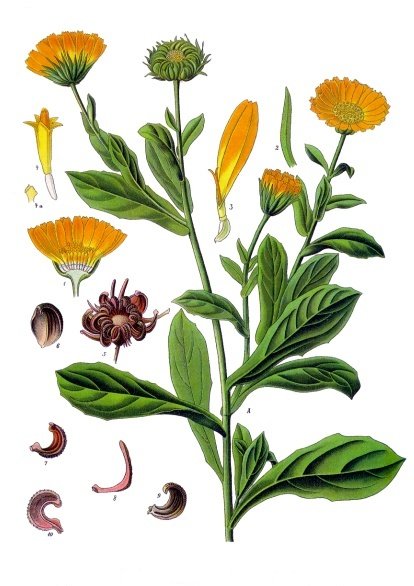
Calendula is an herbaceous perennial, summer annual, or winter annual (depending on climate) that grows up to two feet tall. It may have originally been from southern Europe, but now grows, especially in gardens, all over the world.
The flower heads are orange or yellow or a combination of the two. I’ve also seen ornamental calendula flowers with even more color variations. As is typical in the Aster family, there are both ray and disk flowers. The ray flowers (“petals”) have two little notches at the end.
The flowers have significant bracts that are fragrant and resinous.
The flowers bloom generously through the growing season and thrive in full sun.
The oblong-lanceolate leaves are hairy on both sides and grow about 2-7 inches. The leaves are also fragrant and resinous.
Calendula seeds are a curved achene that look like a small, knobby worm.
Harvesting Tips
Once calendula starts blooming, harvest the entire flower heads daily (including the bracts and petals). This will inspire new flower heads to emerge. I like to harvest the flower buds as they are just opening. I learned from Cascade Anderson Geller that this is when the flower is the most potent. Fully opened flower heads can be used as well. I strongly prefer the orange flowers to the yellow.
Harvest in the morning after any dew has burned off and the flowers are completely dry. You will quickly notice that a slightly aromatic sticky resin covers your picking hand. That’s great - you’ve got good medicine!
Calendula flowers can be tricky to dry. I place them on a drying rack and spread them out so that individual flowers aren’t touching. A dehydrator may be necessary in hot/humid climates. Once they are completely dry, I store them in a paper bag. I have lost a couple of batches of calendula flowers that I stored in glass jars.
Preparation Tips
Calendula can be prepared in a variety of ways.
The tincture is said to be the strongest preparation for calendula’s antimicrobial properties. It can be diluted to use on chicken pox or as a cleansing wash for wounds and fungal infections. I like to wilt the flower heads overnight before infusing with alcohol.
It infuses very nicely into oil, which can then be used in salves, creams, soaps, body butters, facial serums, and many other preparations. I recommend drying the flower heads before infusing into oil.
Calendula makes a wonderful hydrosol that can be spritzed on sunburns, varicose veins, acne, eczema, or simply to maintain healthy skin.
It is also made into a succus, which is a pressing of the fresh plant juice that is then preserved with alcohol.
Many texts recommend using it as a strong infusion. To make this, infuse 1 ounce of calendula flowers into a quart of just-boiled water. Let it steep for 4-8 hours. Strain and drink within a day. This is a fairly bitter blend that will most likely need to be sipped during the day. Although not entirely pleasant to drink, this is the best preparation for healing internal wounds and supporting the liver, immune system, and lymphatic circulation.
Special Considerations
Some people are allergic to members of the Aster family and may also have a reaction to calendula. If you know you are allergic to chamomile, treat calendula with caution.
How to Make Infused Calendula Oil
Infused calendula oil is a wonderful way to enjoy the many gifts of this beautiful plant. When made well, calendula oil can be an absolutely luxurious oil to support your skin health, whether you’re wanting to improve elasticity or to address rashes, clean scrapes, minor burns, and bug bites.
Unfortunately, I see a lot of poorly made calendula oil available out there. There’s three major things that people do wrong.
- The first is that they use only the petals. Ack! Much of the medicine is in the green bits before the petals. You need to use the whole flower head to get the best results.
- The second is that they use way too little flowers! I often see images of infused calendula oil on social media that are so beautiful with just a few flowers resting in lots of oil. It’s beautiful, but it’s weak medicine.
- Lastly, you want to be sure you’re using freshly harvested calendula flowers that have been dried. Calendula loses a lot of its medicinal qualities just six months after harvesting. If your calendula flowers are old and withered then your infused oil will be weak.
Here’s how to make strong calendula oil.
Ingredients:
- 2 cups freshly dried whole Calendula flowers (including petals and sepals) I like to put mine in a blender or food processor to break them down into small pieces
- 2 cups carrier oil of your choice
Directions:
1. Place the Calendula flowers in a pint jar.
2. Pour the oil over the Calendula. Using a clean instrument, stir well and end with pushing the herb under the oil.
3. Tightly cover the jar and label it.
4. Keep the jar on the counter so you can easily keep an eye on it. Every day for the first week, open the jar and stir it well.
4. Infuse the oil for about 4 to 6 weeks or until the oil has taken on the color of the calendula flowers.
5. Strain the oil through a cheesecloth. Squeeze the cheesecloth well to extract the oil from the flowers.
6. Store in a cool, dark place.
There is an art to making powerful herbal infused oils! There’s so many variations between dried herbs vs. fresh herbs and even which oil to use.
Herbal infused oils are one of the many herbal preparations that we teach in our herbal medicine course, Rooted Medicine Circle.

Calendula Fun Fact
Calendula grows easily in containers or in your garden. It attracts many pollinators to its beautiful blooms. This year I’ve seen goldenrod spiders, native sweat bees and bumble bees, honey bees, wasps, hover flies and lace wings visiting the flowers. Calendula also attracts spider mites, whiteflies, thrips, and aphids which are often considered less desirable in the garden. As a result, calendula is often used as a magnet plant, attracting unwanted insects away from vegetables.
Summary of Calendula Benefits
Calendula is many herbalists’ first choice for any number of skin issues, whether it is healing wounds, soothing rashes, or simply promoting healthy skin. It is also incredibly helpful in healing the “internal skin,” which is the mucous membranes. In addition to being a skin-healing wonder, calendula also stimulates the immune and lymphatic systems, supports liver health, and is antimicrobial. It’s a delight to grow, fun to harvest, and can be made into a multitude of herbal potions, from teas and tinctures to creams and salves. This is a beautiful and useful herb to nurture and enjoy.
Citations for Calendula Benefits
Click to show/hide.
Rosalee is an herbalist and author of the bestselling book Alchemy of Herbs: Transform Everyday Ingredients Into Foods & Remedies That Healand co-author of the bestselling book Wild Remedies: How to Forage Healing Foods and Craft Your Own Herbal Medicine. She's a registered herbalist with the American Herbalist Guild and has taught thousands of students through her online courses. Read about how Rosalee went from having a terminal illness to being a bestselling author in her full story here.
